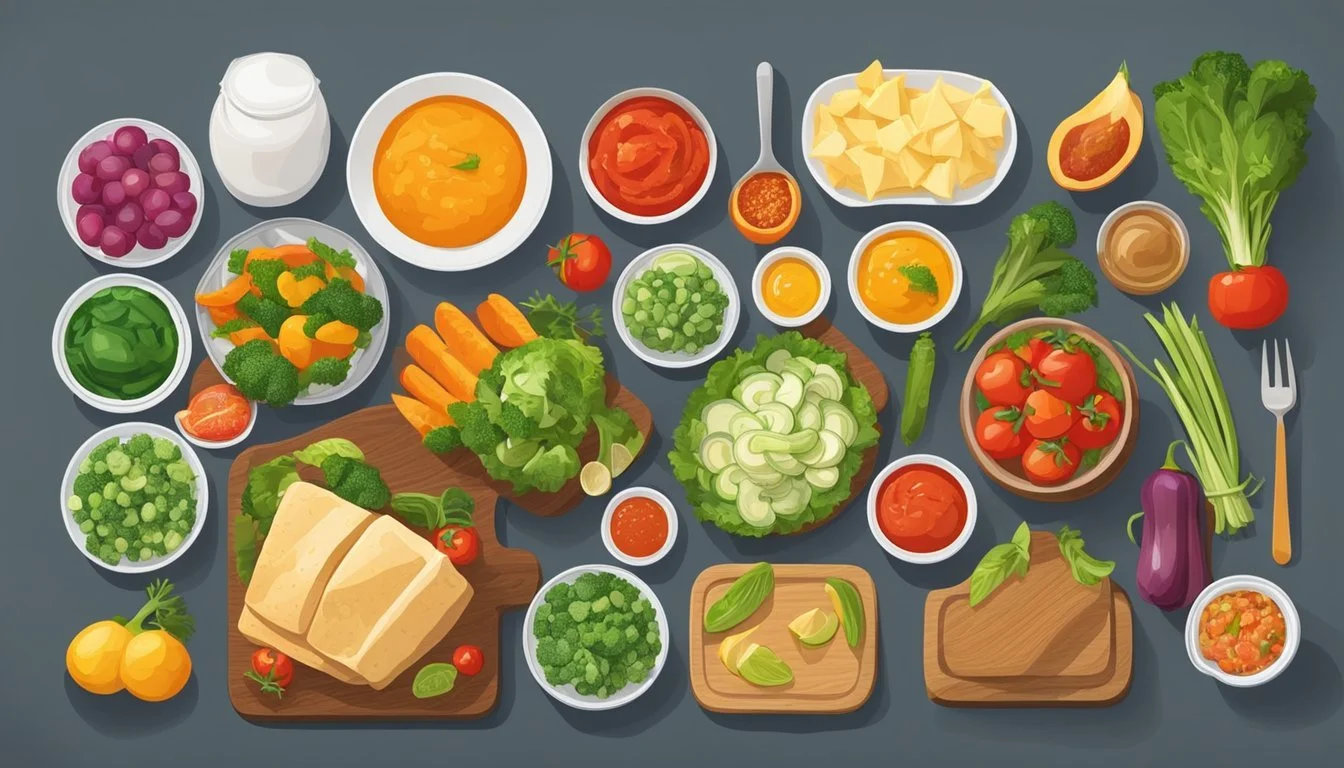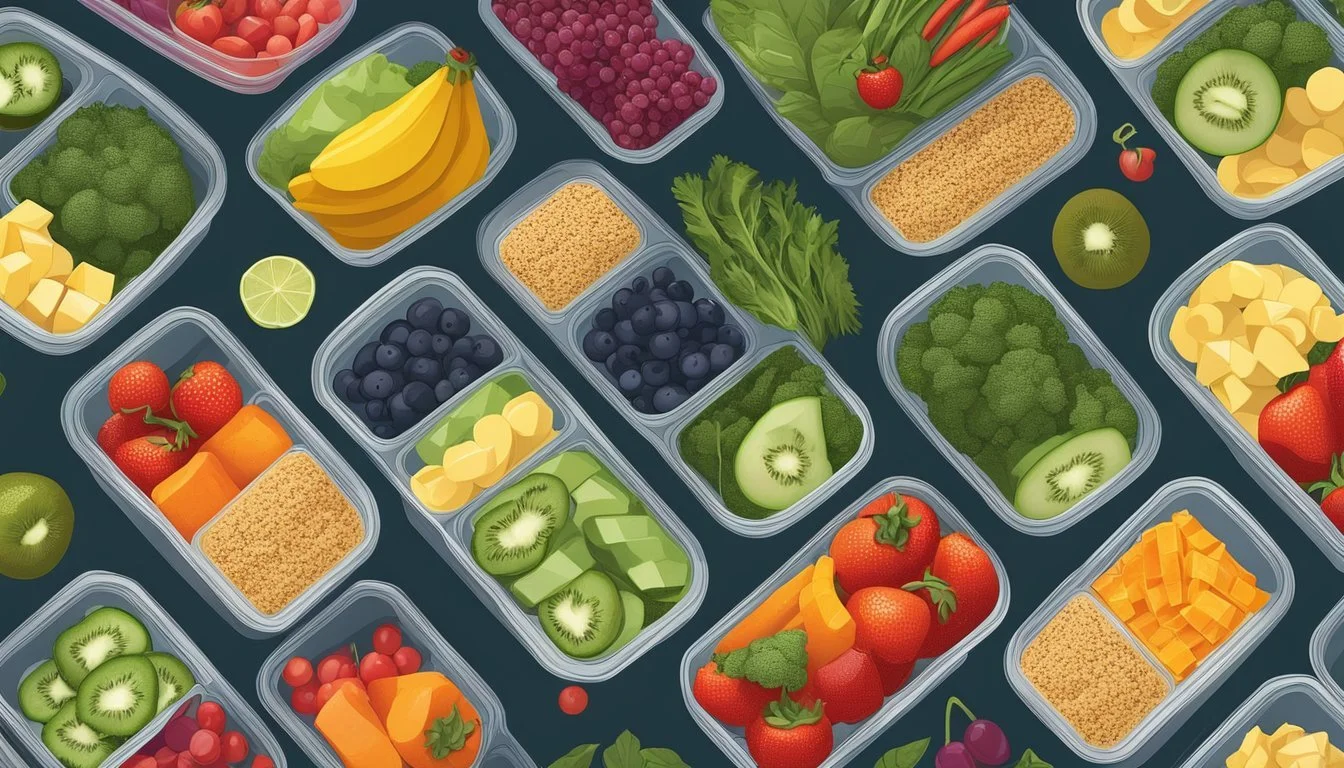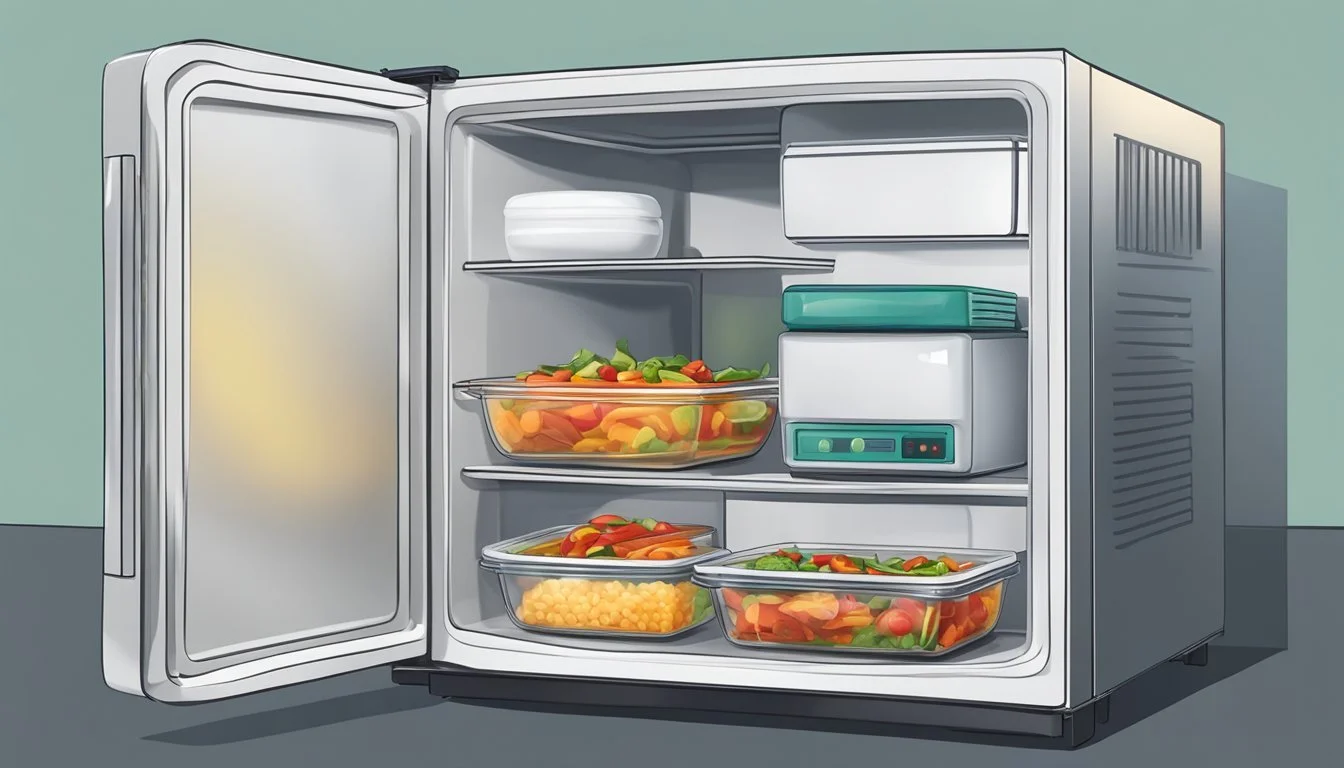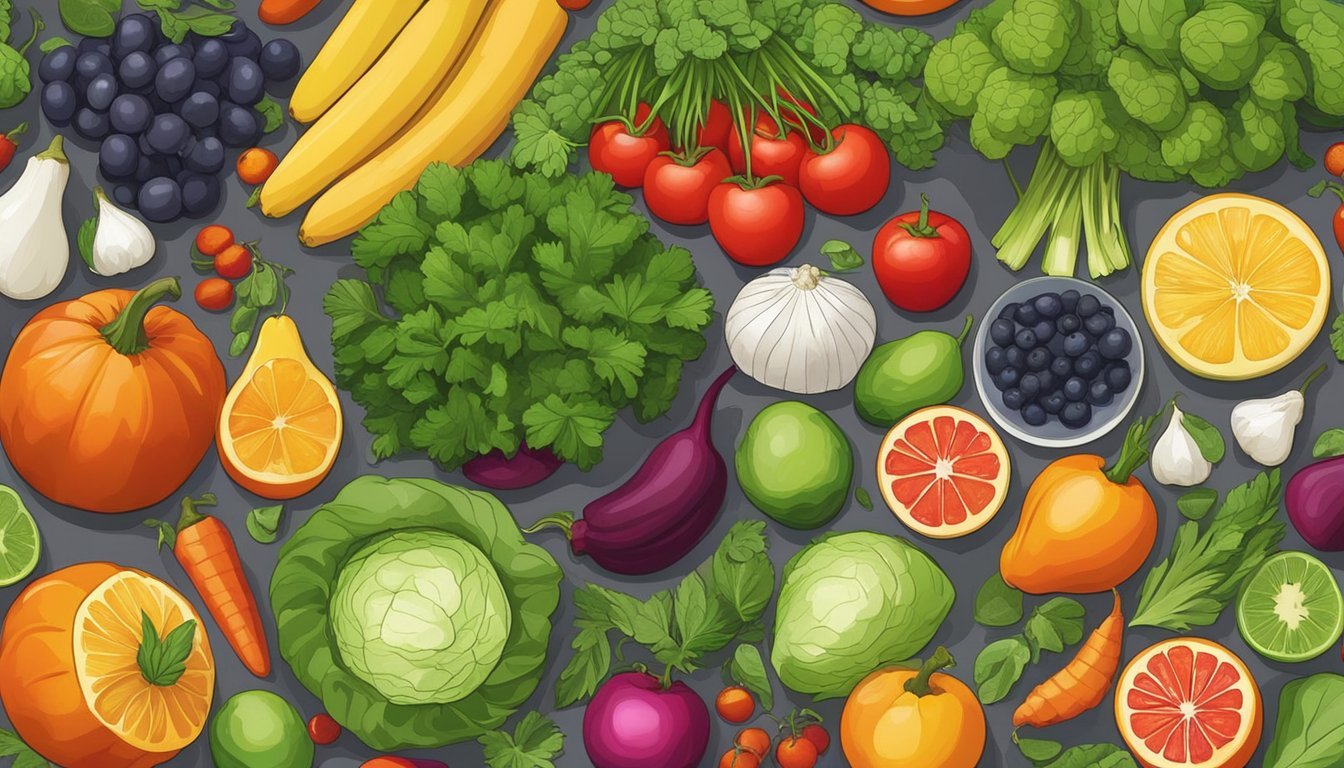Swicy Meal Prep
Planning Ahead for Balanced Sweet-Spicy Flavors
In today's fast-paced world, meal prepping has emerged as a strategic way to ensure a healthy diet amidst busy schedules. Swicy meal prep, a combination of sweet and spicy flavors, is a popular approach that satisfies diverse palates while offering nutritional benefits. Balancing sweet and spicy ingredients not only creates a symphony of flavors but also incorporates a variety of food groups. This can lead to meals that are both satisfying and beneficial to one's health.
They provide an opportunity to plan ahead, reducing the likelihood of impulsive unhealthy choices and saving time during the week. Swicy meals often include lean proteins, vegetables, and complex carbohydrates that are seasoned with an array of spices and herbs, touching on the sweet, savory, and spicy notes. The versatility of flavors allows for creativity in the kitchen, preventing mealtime monotony and encouraging a sustainable meal prep routine.
Incorporating sweet and spicy elements into meal prep requires a balance of ingredients. A dish like Sweet & Spicy Chicken can be prepped with a mix of garlic powder, ginger, and a homemade sauce to cater to both taste profiles, while a Spicy Chicken Meal-Prep Bowl might combine the heat of crushed red pepper with the milder flavors of thyme and coriander to enhance the natural sweetness of accompanying vegetables. Through these methods, individuals are able to personalize their weekly meals to cater to their own taste preferences while maintaining a focus on clean eating.
Understanding Meal Prep
Meal preparation encompasses a strategic approach to planning and cooking meals, which often leads to nutritional balance and time savings throughout the week.
The Basics of Meal Preparation
When it comes to meal prep, it involves selecting a variety of recipes, purchasing the necessary ingredients, and cooking portions in advance. One begins by crafting weekly meal plans, which serve as the foundation for what and how much they will eat each day. A typical process might look like this:
Choosing Recipes: Focus on a mix of proteins, vegetables, and grains to ensure nutrition and variety.
Making a Grocery List: One must identify all the needed ingredients to avoid last-minute shopping trips.
Prepping Ingredients: Washing, chopping, and portioning out ingredients can save significant cooking time.
Cooking in Batches: Individuals often cook large quantities of a dish to have multiple servings throughout the week.
Storing Meals: Properly packaging and refrigerating meals ensures freshness and simplifies future meal times.
Benefits of Meal Prepping
The act of meal prepping carries several benefits that contribute to an individual's health and wellbeing:
Time Efficiency: Cooking in bulk reduces the daily time spent on meal preparation.
Portion Control: Pre-portioned meals help in managing dietary intake and can support weight management goals.
Stress Reduction: Knowing that one's meals are planned and prepared can alleviate the anxiety of last-minute cooking decisions.
Nutritional Balance: Planning allows for incorporating a range of food groups, ensuring a more balanced intake of nutrients.
Cost Savings: Buying ingredients in bulk and avoiding dining out can lead to significant financial savings.
Meal prepping serves as a practical approach to eating that aligns with a busy lifestyle while promoting healthful eating habits. It grants individuals control over the ingredients and portions of their meals, which can enhance their overall diet quality and contribute to their long-term health objectives.
Swicy Meal Components
Swicy meals balance nutrition and taste through the strategic selection of proteins, vegetables, carbohydrates, and the distinctive sweet-spicy flavor profile. Here's how one can build these components effectively for meal prep.
Choosing the Right Proteins
The cornerstone of any swicy meal is its protein. Lean proteins like chicken stand out due to their versatility and ease of preparation. They serve as an excellent canvas for the sweet and spicy sauces that characterize swicy meals. It's essential to ensure that the chicken is coated and cooked well to keep it moist and flavorful. Other proteins suitable for swicy meals may include turkey, fish, or plant-based alternatives for those seeking variety or a vegetarian option.
Recommended Proteins: Chicken, Turkey, Tofu, Tempeh
Selecting Vegetables and Carbs
Vegetables should be chosen for their ability to complement the sweet and spicy flavors as well as their nutritious profiles. Broccoli, carrots, and green beans are fantastic choices that not only bring texture but also a range of essential vitamins and minerals. Carbohydrates like sweet potatoes and cauliflower rice offer a wholesome base, providing sustained energy without overpowering the dish.
Vegetable Options: Broccoli, Carrot, Green Beans
Carbohydrate Sources: Sweet Potatoes, Rice, Cauliflower Rice
Creating the Sweet-Spicy Flavor Profile
The swicy flavor hinges on the balance between sweetness and heat. Sweet elements like honey or maple syrup counteract the fiery punch of chili sauce or fresh peppers. A proper sweet-spicy sauce requires careful tasting and adjustment to achieve the right harmony that will not only appeal to the palette but also enhance the main components of the meal.
Sweet Elements: Honey, Agave, Maple Syrup
Spicy Components: Chili Sauce, Crushed Red Pepper, Fresh Chilies
Preparation Techniques
In crafting a Swicy meal prep plan, one must consider effective cooking methods and the process of assembly and portioning to ensure each meal retains its sweet-spicy balance while being convenient for future consumption.
Cooking Methods
When preparing Swicy dishes, several cooking methods stand out. A skillet is ideal for achieving a crave-worthy sear on proteins like chicken, which is a central component of many Swicy recipes. This technique helps to lock in flavors and create a caramelized exterior that's both sweet and spicy. Additionally, using an Instant Pot or pressure cooker can significantly reduce cooking times without sacrificing the depths of flavor desired in Swicy dishes. These appliances are particularly effective for recipes that traditionally require long simmering times, infusing sweet and spicy flavors into ingredients like legumes and grains. Also, they often come in handy for creating freezer meals that can be quickly reheated.
For swifter meal prep, the microwave can be utilized for steaming vegetables or reheating pre-cooked grains. It is also helpful in melting ingredients that contribute to the overall Swicy profile, like honey or chocolate, which may be used in sauce preparations. It's critical to consider that each cooking method might affect the intensity of sweet and spicy elements differently.
Assembly and Portioning
Once the cooking is complete, Swicy meals should be assembled with care to ensure a balance of flavors and textures. It's beneficial to create a meal plan that guides the portioning of each component ahead of time. This plan typically involves dividing core components—proteins, grains, vegetables, and sauces—into equal portions that are ready to serve. Utilizing meal prep containers that seal well can maintain freshness and prevent flavor cross-contamination.
Portioning is essential for both immediate consumption and freezer meal preparations. Dishes intended to be frozen should be cooled completely before being stored to preserve their quality. The use of labels indicating the date and contents can help maintain an organized freezer and ensure a proper meal rotation. Swicy meals should be thawed safely, ideally in the fridge overnight, and reheated thoroughly before serving to achieve the best taste and texture.
By employing these preparation techniques, one can create a suite of Swicy meals that are both delicious and convenient, aligning with a busy lifestyle without compromising on flavor.
Health and Dietary Considerations
When incorporating swicy flavors into meal prep, one should carefully consider health and dietary needs such as caloric intake, nutritional balance, sodium content, and accommodations for special diets.
Caloric and Nutritional Balance
Effective meal planning ensures each dish has a balanced number of calories and nutrients to foster overall health. For swicy meals, incorporating a variety of fruits and vegetables can contribute essential vitamins and minerals. Lean proteins, whether from animal or plant sources, are critical for maintaining muscle health and should be included. For example, a dish might contain grilled chicken or tofu glazed with a swicy sauce, accompanied by a side of broccoli for iron and sweet potatoes for calcium.
Low Sodium Options
Swicy dishes often contain sauces with high sodium levels. Choose low sodium soy sauce and other reduced-sodium ingredients to manage sodium intake. Consider the following alternatives to reduce sodium content without compromising the swicy taste:
Use low sodium vegetable broths.
Prepare homemade swicy sauces with controlled amounts of salt.
Experiment with herbs and spices like ginger and garlic to enhance flavors instead of salt.
Addressing Special Diets
Swicy meal prep can cater to various dietary restrictions by making simple ingredient swaps. For those following a vegan or dairy-free diet, ensure that swicy sauces are free from animal byproducts. Use plant-based proteins such as lentils or chickpeas as the dish's protein component. For individuals adhering to a low carb diet, one could serve swicy proteins with cauliflower rice instead of traditional grains. It's essential to read labels and be mindful of the hidden carbs and dairy in sauces and condiments.
Recipe Development and Innovation
In the realm of swicy meal prep, both creativity and a deep understanding of ingredient interactions are fundamental in developing recipes that perfectly balance the heat with sweetness.
Creating New Swicy Recipes
When developing new swicy recipes, one often begins with a base of ingredients known for their synergy. Soy sauce and honey offer a classic duo where the umami of the soy sauce complements the sweet notes of the honey. For a more unconventional approach, coconut aminos provide a slightly sweeter and less salty base that pairs well with the boldness of chili paste. Aromatic ingredients like minced fresh ginger root and pressed garlic create depth, while sesame oil lends an earthy nuance ideal for rounding out the sweet and spicy theme.
Key ingredients to consider:
Sweet: honey, raw honey, coconut aminos
Spicy: red pepper flakes, chili paste, hot sauce
Aromatic: garlic, fresh ginger, green onions
Adapting Classic Dishes
Adaptation of classic dishes requires a thoughtful approach to maintain the dish’s integrity while infusing it with the swicy character. One might take a traditional barbecue sauce and introduce raw honey and red pepper flakes. This cues the familiar tangy and sweet taste but adds a heat that lingers. For Asian-inspired meals, tamari can replace soy sauce for a gluten-free option, and hot sauce can be used in place of red pepper flakes for a different heat profile. Green onions and sesame oil serve as garnishes that not only enhance flavor but also add a pop of color and texture to the final presentation.
Ingredient modifications for classic dishes:
Substitute soy sauce with tamari or coconut aminos
Replace sugar with raw honey or honey for a more natural sweetness
Introduce fresh ginger and garlic for complexity
Use red pepper flakes, chili paste, or hot sauce to adjust spiciness levels
Storage and Reheating
Mastering the storage and reheating of meal-prepped dishes can make the difference between a fresh-tasting meal and a disappointing one. Proper techniques ensure that sweet-spicy flavors retain their integrity.
Preserving Freshness
To preserve the freshness of sweet-spicy meal preps, storage temperature and container selection are paramount. Meals should be stored in the fridge at temperatures below 40°F (4°C) to slow down bacterial growth. For freezer meals, ensure you:
Cool down the dishes to room temperature before freezing to prevent the buildup of ice crystals.
Use airtight containers or ziplock bags to protect against freezer burn.
Label containers with the date of storage to track shelf life.
Meals stored in the fridge should be consumed within 3-4 days, while freezer meals maintain their quality for up to 3 months.
Best Practices for Reheating
Reheating should be done in a way that maintains the dish's moisture and texture. For microwave reheating:
Transfer the meal into a microwave-safe dish if it isn’t already in one.
Cover the dish with a microwave-safe lid or vented plastic wrap to trap steam and ensure even reheating.
Stir the meal every 90 seconds to distribute heat thoroughly and avoid cold spots.
In cases where a dish might dry out, adding a small amount of water, oil, or butter before reheating can help retain its moisture. For oven reheating, covering the dish with foil can serve a similar purpose.
Meal Prep for Different Lifestyles
Planning meals ahead of time can cater to different lifestyle needs, whether it's for individuals, families, or those focused on fitness. Here are specific strategies for each group:
Meal Prepping for Singles
Singles often benefit from meal prep ideas that are both convenient and tailored to their preferences. Lunch meal preps can include a mix of sweet and spicy flavors, like a Zucchini Noodles with Quick Turkey Bolognese that is low in carbohydrates yet rich in taste. They might also enjoy flexibility and variety, preparing dishes that can be easily repurposed into other meals or shared with friends when needed.
Family-Friendly Meal Prep
Meal prepping for a family often means finding the balance between nutritious and comfort food that appeals to both adults and children. Recipes such as a skillet meal with turkey sausage, peppers, and onions can be a hit. It's a meal that's both easy to prepare and store, making it ideal for busy family schedules.
Meal Prep for Fitness Enthusiasts
For fitness enthusiasts, meal prep is less about convenience and more about meeting nutritional goals. Lunches could be built around lean proteins and whole grains to support exercise routines. Preparing a mix of proteins like chicken breast or salmon with a variety of vegetables ensures balanced nutrition and helps with muscle repair and recovery after workouts.
Enhancing Flavor and Nutrition
In meal prep, the strategic use of herbs, spices, and balanced flavor profiles not only creates exciting dishes but also contributes to the nutritional value. By considering the properties of each ingredient, one can enhance the overall taste and health benefits of swicy meals.
Utilizing Herbs and Spices
Herbs and spices offer a treasure trove of flavors without adding significant calories. For example, incorporating ginger into swicy dishes can lend a warm, aromatic flavor as well as anti-inflammatory benefits. Meals can be seasoned with garlic, which pairs well with both sweet and spicy components while providing cardiovascular benefits. A sprinkle of sea salt can heighten the natural flavors of vegetables while keeping sodium levels in check compared to regular table salt.
Ginger: anti-inflammatory, adds a warm note to dishes.
Garlic: supports heart health, enhances savory elements.
Sea Salt: Provides minerals, less processed than table salt.
Using these ingredients, cooks can build a complex flavor profile that's as nutritious as it is delicious.
Balancing Sweet and Spicy Elements
The key to a successful swicy meal is in the balance between sweet and spicy. Brown sugar can caramelize well, offering deep sweetness and color to dishes like stir-fries that include sugar snap peas. However, moderation is crucial as sugar can quickly overpower a dish. To balance the heat, not just any oil will do; olive oil has a neutral taste that carries the flavors of spices without adding extra heat, unlike some other oils.
For thickening sauces that accompany swicy meals, cornstarch is a versatile thickener that does not affect flavor and helps create a glossy, appealing texture. Use it sparingly to maintain the natural consistency of the sauce without overwhelming the dish's other elements.
Brown Sugar: Adds deep sweetness, use sparingly for balance.
Olive Oil: Carries flavors without overpowering, adds healthful fats.
Cornstarch: Neutral thickener for sauces, used in moderation.
By carefully balancing these elements, chefs can ensure each meal is a perfect blend of sweet heat and nutritionally sound.
Swicy Meal Planning Strategies
Swicy meal prep combines the allure of sweet and spicy flavors into nutritious meals that can be planned ahead of time, focusing on portion control and grocery budgeting.
Weekly Planning
A successful weekly meal plan for swicy eating involves mapping out each meal to ensure a variety of nutritionally balanced options. Meal prep is crucial for swicy meals as it allows the individual to plan the use of ingredients like gochujang and hot honey that define the swicy flavor profile. It's beneficial to include grains such as quinoa and brown rice that can balance the bold swicy flavors while adding nutritional value.
Portions: Measure ingredients ahead for daily meals to maintain portion control.
Flavors: Incorporate a mix of sweet and spicy components to create a balanced swicy profile for each meal.
Preparation: Utilize batch cooking methods such as roasting chicken spiced with paprika or simmering grains to streamline the meal prep process.
Budgeting for Meals
Cost-efficiency in swicy meal prep is achieved by purchasing ingredients in bulk and using them across multiple meals throughout the week. To stay within a grocery budget, shoppers should prioritize versatile staples like chicken and whole grains that can be used in various swicy dishes.
Buy in Bulk: Select sweet and spicy condiments, spices, and non-perishables in larger quantities for cost savings.
Seasonal Produce: Opt for seasonal fruits and vegetables to add sweetness and nutrition without overstepping the budget.
Efficient Shopping: Create a grocery list that doubles up ingredients for different meals to avoid unnecessary purchases.
Serving and Presentation
In the culinary world of swicy meal prep, presentation enhances the dining experience while preserving the integrity of both sweet and spicy flavors. Here are some tips to serve and showcase your meals.
Plating Techniques
When plating food, consider the balance between the sweet and spicy elements. Use white or neutral-colored plates to make the colors of the food stand out, and allocate space on the plate to separate components if needed. For example, a streak of spicy sauce can be drizzled next to a mound of lightly glazed, sweet chicken to provide visual contrast and allow diners to control their flavor experience.
Contrast: Utilize contrasting colors for visual appeal. For instance, bright reds from a spicy element against the creamy green of an avocado slice.
Height: Build height with elements like protein to add dimension.
Garnish: Garnish with herbs or edible flowers for a pop of color and freshness.
Serving Swicy Meals
When it comes to serving swicy meals in a meal prep context, organization is key. Containers should be microwave-safe if the meal is to be reheated, and compartments help in keeping flavors from melding together too much before serving.
Lunch Containers: Opt for bento-style boxes with compartments or use silicone cupcake liners to separate ingredients.
Portion Control: Aim for balanced proportions of proteins, vegetables, and grains.
Temperature: Keep sweet elements like fresh fruit at a cool temperature, while ensuring spicy components can be warmed without affecting their spice level.
In serving swicy meals, one has to consider not only how the meal tastes but also how it's presented and served to maintain both aesthetic and flavor profiles.
Swicy Meal Variations and Modifications
Incorporating swicy flavors into meal prep requires flexibility and a seasonally minded approach to ingredients. The following sub-sections explore strategies for adapting to what’s available and enhancing dishes with the sweet-spicy balance that defines swicy cuisine.
Adapting to Ingredient Availability
For protein, whether one has access to boneless skinless chicken breasts (What wine goes well with chicken breast?), chicken thighs (What wine goes well with chicken thighs?), or other meats, the key is to season them appropriately with a balance of sweet and spicy elements like honey and chili powder. When specific vegetables or fruits aren’t available, meal preppers should feel confident substituting similar textures or flavors, such as swapping bell peppers for zucchini in a stir-fry, ensuring the swicy flavor profile remains intact.
In terms of grains, rice can be replaced by alternatives like pasta or noodles to complement the chosen proteins and veggies. This not only keeps the meal interesting but also allows for flexibility when pantry staples are low. For example:
Rice Shortage?
Try: Quinoa or barley
No Noodles?
Try: Zucchini spirals or spaghetti squash
Creating Seasonal Swicy Dishes
Crafting swicy dishes with a seasonal twist involves harnessing the flavors of the current season. In summer, lighter proteins such as grilled chicken breast or thighs can be marinated in a mixture of sweet mango and habanero for a refreshing swicy kick. For the winter months, heartier burrito bowls that incorporate roasted sweet potatoes, spiced with cinnamon and cayenne, can bring warmth to the palate.
Sheet pan meals offer an easy method for roasting combinations of seasonal vegetables and proteins to create swicy variations. For example:
Autumn Swicy Sheet Pan:
Protein: Chicken thighs
Veggies: Carrots and parsnips
Swicy Element: Maple syrup and chipotle
Summer Swicy Grill:
Protein: Boneless chicken breasts
Veggies: Bell peppers and corn
Swicy Element: Pineapple juice and jalapeño
Through these subsections, one learns the essence of crafting swicy meals that are adaptable based on what ingredients are at hand, without sacrificing the core sweet-spicy flavor profile. By following these guidelines, individuals are empowered to create swicy meal variations that are both delightful and practical for meal prep.
Advanced Meal Prep Techniques
Incorporating advanced meal prep techniques helps streamline the cooking process for sweet-spicy cuisine. With focus on bulk cooking and utilizing kitchen gadgets, one can prepare flavorful meals while saving time.
Bulk Cooking
Bulk cooking is a strategy where large quantities of a meal or certain meal components are prepared at once. This approach is especially efficient for complex flavors like sweet and spicy that may require more preparation time. For instance, cooking a sizeable batch of a sweet-spicy chicken marinade or sauce can reduce time spent in the kitchen throughout the week. Here's how to implement bulk cooking effectively:
Choose recipes that scale well, like soups, stews, or marinated dishes.
Prepare in large quantities, ensuring you have adequate storage.
Use a variety of cooking methods:
Skillet: Sauté spices and aromatics to deepen flavors.
Oven: Roast or bake multiple trays of seasoned meats or vegetables.
Pressure cooker/Instant Pot: Cook grains or legumes promptly while retaining their punchy flavors.
Utilizing Kitchen Gadgets
Kitchen gadgets can be a boon for the seasoned meal prepper, optimizing cooking times and enhancing flavor profiles. Here's how to leverage these gadgets:
Pressure Cooker/Instant Pot: For sweet-spicy recipes that typically take hours, these gadgets can reduce the cooking time significantly while infusing deep flavors into every bite.
Microwave: Utilize it for quick defrosting of pre-prepped ingredients or rapid cooking of certain components like steamed vegetables.
Food Processor: Quick preparation of sauces, marinades, or dressings—combine sweet and spicy elements like honey and chili with a few pulses.
Gadget Use-case Benefit Pressure Cooker Tenderize meats for sweet-spicy stews. Speeds up cooking, retains flavor. Instant Pot Cook grains to accompany spicy dishes (What wine goes well with spicy dishes?). Multiple uses; more than just pressure cooking. Microwave Reheat prepped meals quickly. Convenience and time-saving. Skillet Caramelize ingredients for added depth. Imparts a smoky note to the sweet-spice palate.
By mastering bulk cooking and adeptly using kitchen gadgets, one can ensure that delicious sweet-spicy meals are ready to be served at a moment's notice.
Interactive Elements
When it comes to meal prep, engaging with a community can enhance the experience. Seeking feedback and sharing ideas fosters a dynamic environment where sweet-spicy enthusiasts can thrive.
Gathering Feedback and Comments
Encouraging feedback from others can significantly improve the quality of meal prep recipes. Presenting a dish to a community through social media platforms allows for collective input, where members can leave comments and suggestions. This collaborative approach can lead to tailoring recipes that suit a wide range of palates, ensuring a diverse collection of sweet-spicy meal preps. Additionally, it can help in identifying areas of a recipe that may need refinement or creative adjustment.
Feedback Sources:
Social media posts
Community forums
Meal prep sharing platforms
Sharing Your Meal Preps
Once a meal prep has been perfected with community feedback, sharing the detailed recipes can inspire others and contribute to the repository of swicy meal preps. Utilizing platforms that allow for recipe exchanges can not only showcase an individual's creation but also encourage a sense of community. The act of sharing can lead to the discovery of new flavor combinations and preparation techniques that others might not have considered.
Methods of Sharing:
Blog posts with well-documented steps
Video tutorials
Detailed meal prep guides with photos
By engaging in these interactive elements, individuals not only perfect their own meal prep approach but also contribute to a larger community enjoying the harmony of sweet and spicy flavors.
Conclusion
Meal prepping with a focus on 'Swicy' flavors—that delightful blend of sweet and spicy—can add a vibrant twist to weekly menus. Incorporating this trend into meal preparation ensures that individuals have access to enjoyable and varied dishes throughout the week.
One should aim for balance when planning swicy meals. By using sweet elements such as honey, and spicy components like chili peppers, a harmonious flavor profile can be achieved. Preparing sauces and seasonings in advance simplifies cooking processes and allows for consistency in taste.
To incorporate swicy flavors effectively, consider the following tips:
Organize Ingredients: Group your sweet and spicy condiments and ensure they are easily accessible.
Diversify Your Dishes: Apply the swicy flavor profile across various meals to keep things interesting—think chicken, vegetables, or even seafood.
Health Considerations: Opt for natural sweeteners and fresh spices to maintain a healthy balance.
In summary, swicy meal prep is not only about embracing a food trend, but also about enhancing the culinary experience with convenience and balance in mind. With proper planning and creativity, sweet and spicy dishes can become a highly anticipated feature of anyone’s meal plan.















